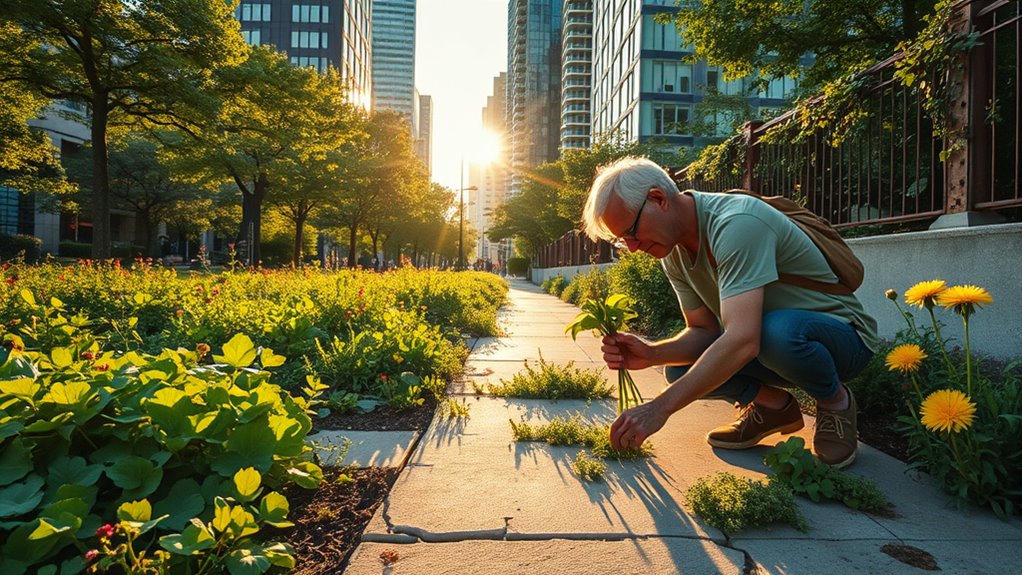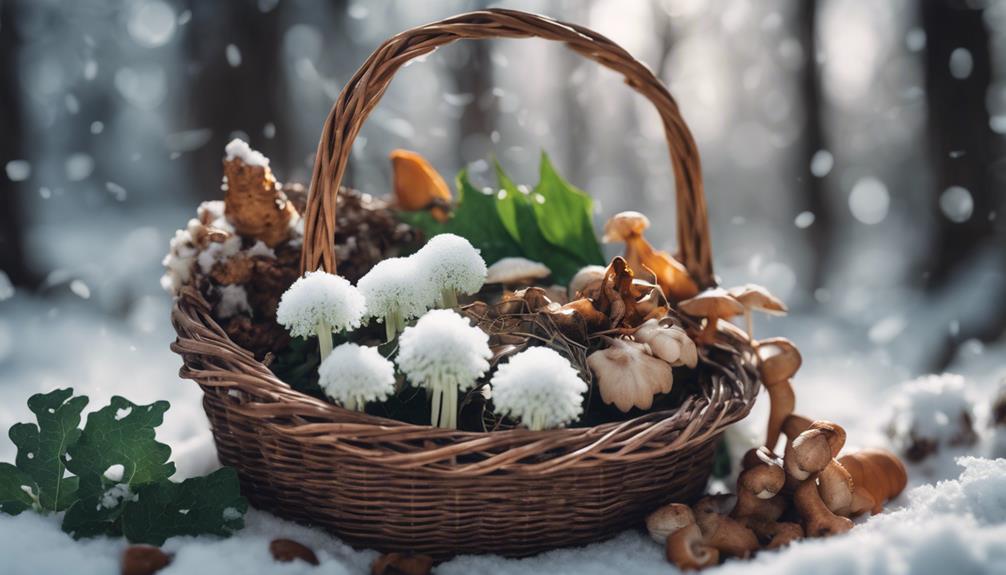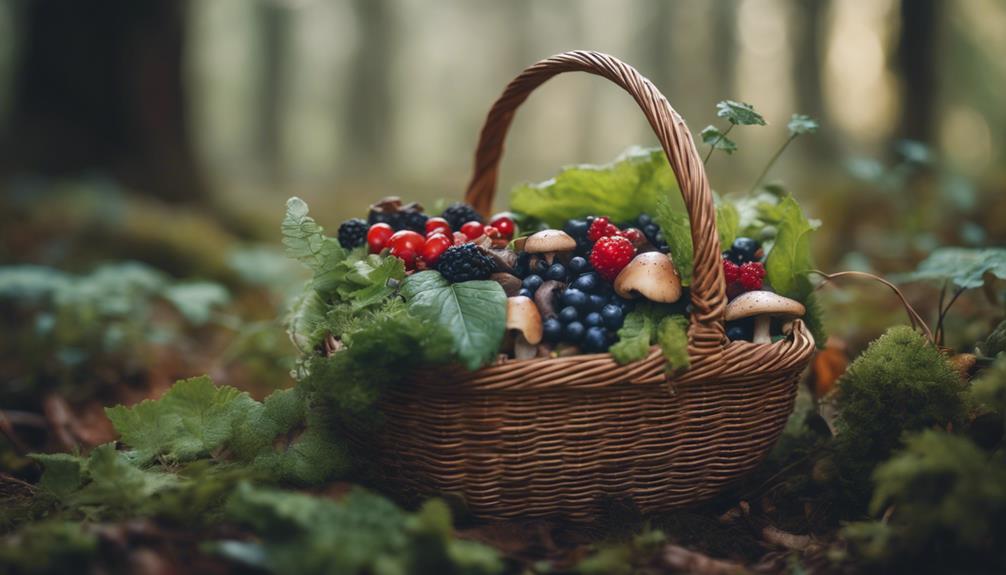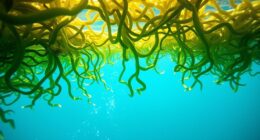Urban foraging lets you find edible plants like figs, wild plums, and ginkgo leaves growing naturally in parks, vacant lots, and fence lines. By learning to identify key features and using simple tools, you can harvest safely and ethically. These wild foods are nutritious, support local ecosystems, and reduce environmental impact. Want to discover which city plants can boost your meals? Keep exploring to uncover more tips and ideas.
Key Takeaways
- Identify edible urban plants like figs, wild plums, and bay leaves by recognizing their unique features and scents.
- Use tools like foraging guides, apps, and containers to safely harvest and verify plant species.
- Follow legal regulations, seek permissions, and practice ethical harvesting to protect ecosystems and ensure sustainability.
- Incorporate wild urban foods into meals to enhance nutrition, flavor, and support local food initiatives.
- Promote environmentally friendly practices that conserve native plants, reduce waste, and foster community connection with nature.
Discovering Edible Plants Hidden in Urban Spaces

Many edible plants naturally grow in urban spaces like parks, vacant lots, and along fence lines, often going unnoticed. As you explore urban foraging, you’ll discover wild foods such as figs, wild plums, and ginkgo leaves thriving in green spaces. Recognizing these plants requires careful plant identification, focusing on distinctive features like leaf shape, fruit, and growth patterns. Be aware of invasive species that may resemble edible plants but are best avoided. City parks and fence lines are accessible spots to find these food sources, making local food more attainable. Using foraging guides, apps, and community maps helps you safely locate and identify edible plants amid urban landscapes. Additionally, understanding the nutritional value of local wild foods can enhance your foraging experience and ensure you choose nutrient-dense options. Developing a plant identification skill set is essential to distinguish edible plants from look-alikes and avoid potential toxins. Gaining knowledge about urban ecology can help you better understand where these plants thrive and how they interact with their environment. Recognizing the interconnectedness of ecosystems can deepen your appreciation of urban biodiversity and support sustainable foraging practices. Exploring biodiversity hotspots within cities can reveal rare and valuable species that support local ecosystems. With attention and respect, you can turn overlooked city greenery into valuable foraged foods.
Essential Tools and Techniques for Safe Foraging

To forage safely, it’s essential to equip yourself with the right tools and techniques. First, carry practical tools like reusable baskets, small containers for berries, and a pocket knife or shears for harvesting. These help with efficient collection and minimize damage to plants. Second, use plant identification apps like iNaturalist or Seek to verify species, cross-referencing with regional field guides for recognition. This guarantees you confidently distinguish edible plants from look-alikes. Third, develop good techniques by observing visual features, tactile textures, and smells to assess edibility and ripeness. Always prioritize safety by avoiding uncertain or poisonous plants. Mastering these tools and recognition techniques keeps your urban foraging both enjoyable and safe, helping you harvest responsibly in city environments. Additionally, understanding the color accuracy of your tools and environment can improve your ability to correctly identify plants under different lighting conditions. Being aware of space efficiency principles from tiny house design can also inspire more organized and effective foraging setups, ensuring you maximize your harvest without clutter.
Identifying and Harvesting Common City Forageables

Building on your knowledge of tools and techniques, recognizing common city forageables is key to safe and successful urban foraging. In city parks and green spaces, you’ll find edible plants like figs, ginkgo leaves, bay leaves, wild plums, and pineapple weed. Proper plant identification is essential—look for figs’ honey-sweet fruit and coconut-scented leaves, ginkgo’s fan-shaped leaves and stinky fruits, bay leaves’ mature, fragrant leaves, and wild plums’ sweet, tangy fruit. Use foraging tips such as harvesting only what you need and avoiding protected species. Always check local regulations to confirm foraging is permitted in your area. Foraging safety considerations are crucial to prevent accidental ingestion of toxic plants and ensure sustainable harvesting. Being aware of plant toxicity is vital to avoid dangerous look-alikes and ensure your foraging remains safe and sustainable. Additionally, understanding urban biodiversity can help you identify a wider variety of edible plants in the environment around you. Recognizing plant identification techniques is essential for distinguishing between safe and harmful species. Incorporating knowledge about noise levels of modern heat pumps can also serve as an analogy for understanding the importance of respecting natural and built environments while foraging. With sharp observation and responsible harvesting, you can enjoy wild edibles safely within the urban environment.
Navigating Regulations and Ethical Foraging Practices

Traversing regulations and practicing ethical foraging are essential steps to guarantee you stay within legal boundaries and protect the environment. To do this effectively: 1. Research local laws to confirm whether harvesting is allowed in public spaces or private property, and always seek landowner permission when necessary. 2. Be aware of protected species and avoid collecting threatened plants, supporting conservation efforts and sustainable foraging. 3. Follow ethical guidelines by not overharvesting, minimizing disturbance to wildlife, and respecting natural habitats. Additionally, understanding sound healing science resources can provide valuable insights into site security and data management, which can be useful when foraging for edible or medicinal plants to ensure safety and proper identification.
Benefits of Urban Foraging for Health and Sustainability

Urban foraging gives you access to nutrient-rich, pesticide-free wild foods that often pack more vitamins and minerals than store-bought produce. By foraging locally, you help reduce the environmental impact of food transportation and support sustainable practices. Additionally, engaging in foraging can help sharpen your knowledge of edible plants in urban environments and their seasonal availability. Plus, it encourages a stronger connection with nature while promoting healthier, more eco-friendly food choices. Incorporating fresh, wild foods into your diet can also boost your overall nutrient intake and diversify your meals. Additionally, using eco-friendly transportation methods like flat iron bikes can further enhance your sustainable living efforts. Exploring urban ecosystems reveals a rich variety of edible plants and herbs that thrive in city environments, making foraging an accessible activity for many.
Nutrient-Rich Wild Edibles
Have you ever considered that wild edibles growing nearby might be more nutritious than store-bought produce? When you engage in urban foraging, you access nutrient-dense plants like wild plums, figs, and ginkgo leaves, which often contain higher levels of vitamins, minerals, and antioxidants. These edible plants, especially native species, thrive naturally in local ecosystems, making them safer and pesticide-free options. Engaging in community engagement can also enhance your foraging experience and deepen your connection to local biodiversity. Additionally, understanding local ecosystems can improve your ability to identify and sustainably harvest native edible plants.
Here are three benefits of foraged plants:
- They provide essential nutrients like vitamin C, calcium, and iron, supporting your health.
- Wild food offers diverse flavors and increased nutrient profiles compared to conventional produce.
- Foraging native species helps sustain local ecosystems and promotes sustainable food sources.
Promotes Sustainable Practices
By foraging for wild edible plants in city environments, you actively promote sustainable practices that benefit both your health and the planet. Using native plants reduces reliance on resource-intensive agriculture, helping conserve local ecosystems. Harvesting resilient native species minimizes food waste by turning overlooked plant species into nutritious food sources. Urban foraging decreases transportation emissions, supporting a low-carbon-footprint lifestyle. Wild edible plants often contain higher levels of vitamins, minerals, and antioxidants, enhancing nutrition sustainably. Engaging in foraging also boosts environmental awareness, encouraging stewardship of native species and biodiversity within the urban environment. Native plants are often well-adapted to urban conditions, making them a reliable and sustainable food source. Recognizing the vibrational energy of these plants can further enhance your connection to nature and improve your overall well-being. By recognizing and utilizing native plants, you contribute to maintaining healthy local ecosystems while enjoying fresh, sustainable food options. This practice fosters a more sustainable, environmentally conscious way to nourish yourself in the city.
Turning Foraged Finds Into Delicious, Nutritious Meals

Transforming foraged finds into tasty, nutritious meals is a creative way to connect with your environment and boost your health. Urban foraging offers a variety of edible plants and wild ingredients that can elevate your meals.
Turning wild foraged ingredients into delicious, healthy meals connects you with nature and enhances your diet.
- Use wild plums, elderberries, or purslane in jams, salads, and smoothies to add flavor and nutrition.
- Season soups and teas with edible plants like bay leaves or ginkgo leaves for unique tastes and health benefits.
- Experiment with wild herbs such as chickweed and lamb’s quarters in pestos, herbal teas, or fresh greens to diversify your diet.
Frequently Asked Questions
What Is the 1 3 Rule for Foraging?
The 1 3 Rule for foraging tells you to only take one-third of a plant when harvesting. This way, you leave enough behind for the plant to grow back and for wildlife to thrive. By following this rule, you help protect the environment and ensure sustainable foraging. It’s a simple but effective way to enjoy wild foods responsibly while keeping ecosystems healthy for future foragers.
Is Foraging for Food Illegal?
You might wonder if foraging for food is illegal. It depends on where you are; laws vary widely by location. In some areas, foraging is allowed if you follow specific rules, but in others, it’s prohibited, especially on protected lands or private property. Always check local regulations first. By doing so, you avoid legal issues and help protect the environment while enjoying urban foraging responsibly.
What Is the Rule of Three Foraging?
You might think foraging is all about grabbing as much as you can, but the Rule of Three proves otherwise. It’s a simple, clever way to safeguard plants, wildlife, and your city’s green spaces. By limiting yourself to three parts, servings, or types of plants, you ensure sustainability. So, instead of overharvesting, you’re helping nature thrive, all while enjoying your urban adventure responsibly—who knew restraint could be so rewarding?
What Is the Golden Rule of Foraging?
The golden rule of foraging is to always positively identify each plant or mushroom before you eat it. You need to be confident it’s safe, so double-check with trusted sources or experts. Also, harvest sustainably by taking only what you need and leaving enough for the plants to grow back. Avoid polluted areas, respect property laws, and never consume unknown foods to keep yourself safe.
Conclusion
Urban foraging opens a secret garden right outside your door, waiting to be explored. With a keen eye and respectful hands, you can turn city weeds into nourishing treasures and savor the wild flavors hiding in plain sight. Think of yourself as a modern explorer, uncovering nature’s hidden bounty beneath the concrete jungle. Embrace this adventure, and watch as your city transforms into a vibrant, edible tapestry—delicious, sustainable, and all yours to discover.










